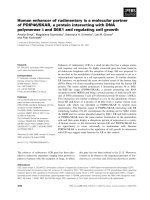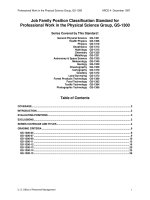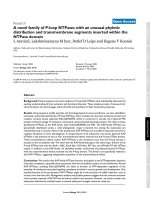Glial cell line drived neurotrophic factor (GDNF) family of ligands is a mitogenic agent in human glioblastoma and confers chemoresistance in a ligand specific fashion
Bạn đang xem bản rút gọn của tài liệu. Xem và tải ngay bản đầy đủ của tài liệu tại đây (1.74 MB, 203 trang )
GLIAL CELL LINE-DERIVED NEUROTROPHIC
FACTOR (GDNF) FAMILY OF LIGANDS IS A
MITOGENIC AGENT IN HUMAN GLIOBLASTOMA
AND CONFERS CHEMORESISTANCE IN A
LIGAND-SPECIFIC FASHION
DR NG WAI HOE
MBBS (NUS), FRACS (NEUROSURGERY)
A THESIS SUBMITTED FOR THE DEGREE OF
DOCTOR OF MEDICINE
JULY 2007
DEPARTMENT OF BIOCHEMISTRY
NATIONAL UNIVERSITY OF SINGAPORE
ACKNOWLEDGEMENTS
I would like to express my gratitude to Associate Professor Too Heng Phon for
his guidance and encouragement and opening my eyes to the challenging and engaging
world of basic research. The various discussions we have had over the past few years
have taught me lessons beyond the laboratory.
I also acknowledge the help from my colleagues in the laboratory (John, Li
Foong and Zhun Ni) who have patiently guided me through the nuances of laboratory
techniques, thereby allowing me to circumnavigate the steep learning curve.
The Singapore Millennium Foundation (SMF) has been very supportive in my
research endeavour and provided me with valuable scholarship support without which
this research would have been not possible.
My employers, the National Neuroscience Institute (NNI) have been steadfast in
their support in my training as a fledging clinician-scientist for which I am forever
grateful.
Most importantly, I am thankful to God, who is the author of all knowledge and
whose wisdom is incomprehensible. In my quest for knowledge, I am constantly humbled
by how little I know, and how much remains unknown.
Lastly, I dedicate this work to my family (Claire, Seth and Kaela) who mean the
world to me and who are my biggest fans.
2
TABLE OF CONTENTS
CHAPTER 1
INTRODUCTION
1.1 Brain Tumours
1.2 Astrocytomas
1.3 Malignant Astrocytoma
1.4 Epidemiology of Malignant Astrocytoma
1.5 Aetiology
1.6 Genetic Factors
1.7 Environmental Factors
1.7.1 Radiation
1.7.2 Chemicals
1.7.3 Diet
1.7.4 Tobacco
1.7.5 Drugs
1.7.6 Infection
1.7.7 Mobile Phone
1.8 Clinical Features
1.9 Management
1.10 Limitations in Treatment
1.11 Molecular Biology
1.11.1 Multi-step Theory of Tumourigenesis
3
1.11.2 Glioma Invasiveness
1.11.3 Angiogenesis
1.11.4 Glioma Signaling Pathways and Growth Factors
1.12 Glial Cell-Line Derived Neurotrophic Factor (GDNF) Family
1.12.1 GDNF Family of Ligands (GFL)
1.12.2 GDNF-Family Signalling
1.12.3 RET Dysfunction and GDNF in Disease
1.12.4 GDNF and Cancer
1.12.5 GDNF and Malignant Astrocytoma
1.12.6 GFRα Splice Isoforms/Variants
1.13 Objective of Research Project
CHAPTER 2
MATERIALS AND METHODS
2.1 Cell Culture
(a) Cell Lines
(b) Cell Stock
(c) Maintenance of Cell Lines
2.2 Human Glioma Specimens
(a) Ethics Approval
(b) Patient Consent
(c) Specimens
4
2.3 Quantitative Real Time Polymerase Chain Reaction (PCR)
(a) Reverse Transcription (RT) Reaction
(b) Sequence Independent Real-Time PCR using SYBR Green I
Plasmids Construction
(c) Sequence Independent Real-Time PCR
2.4 1,3-Bis(2-chloroethyl)-1-nitrosourea (BCNU)
2.5 Ligands
2.6 Cytotoxicity Assay
(a) MTS Assay
(b) Normalisation of MTS Assay
(c) Propidium Iodide (Pi) Staining
2.7 Western Blot
(a) Protein Quantification by BCA Assay
(b) SDS-polyacrylamide gel electrophoresis (SDS-PAGE)
(c) Western blotting and detection
2.8 Study on the Impact of Cell Tumour Burden on Chemoresistance
2.9 Study on the effects of GDNF and NRTN on BCNU chemotherapy and its
role in chemoresistance
CHAPTER 3
RESULTS
3.1 Higher glioblastoma cell loading required higher concentration of BCNU to
acheive similar cell cytotoxicity
5
3.2 Morphology of Cells
3.3 Cell Proliferation of Assay
3.4 GDNF Expression Level
3.5 Expression of RET Isoforms (RET 9 and RET 51)
3.6 Expression of NCAM
3.7 Expression of GFRα1a
3.8 Expression of GFRα1b
3.9 Differential Expression Levels of GFRα1b and GFRα1a
3.10 Expression of GFRα2
3.11 Study of Effects of GDNF on BCNU chemotherapy
3.12 Study on the Effects of NRTN on BCNU chemotherapy
3.13 Signaling Mapping on stimulation with BCNU and GDNF for LN-229 and
A172
CHAPTER 4
DISCUSSION
4.1 Role of Radical Surgery
4.2 Why surgical resection then?
4.3 Higher glioblastoma tumour burden reduces efficacy of BCNU
chemotherapy: in vitro evidence to support radical surgery for malignant
gliomas
4.4 Growth Factors
4.5 Cellular Signalling
6
4.6 Paracrine and Autocrine Loops in Cancer
4.7 Paracrine and Autocrine Loops in Gliomas
4.8 Glial Cell Line-Derived Neurotrophic Factor (GDNF) Family
4.9 GDNF and Malignant Gliomas
4.10 Splice Isoforms/Variants
4.11 Splice Variants in Gliomas
4.12 Potentiation of Chemoresistance
4.13 Signalling Mapping
CHAPTER 5
FUTURE STUDIES
BIBLIOGRAPHY
APPENDICES
7
SUMMARY
High-grade gliomas are highly malignant tumours. Standard therapy includes surgical
resection, radiation therapy and chemotherapy. However, in spite of advances in surgical
techniques, medical technology, radiation therapy, chemotherapeutic regimens and other
forms of therapy, the overall prognosis remains poor. The median survival of anaplastic
astrocytoma and glioblastoma is about 3 years and 1 year respectively. Sadly, the survival
outcome has not significantly improved the past 2-3 decades.
Surgery plays an important role in the management of high-grade gliomas.
Surgery is critical for histological diagnosis of high-grade gliomas. Aggressive tumour
resection can also rapidly reduce the intracranial hypertension associated with bulky
disease and provide symptomatic relief and improved quality of life. The most
contentious issue surrounds the controversy on whether surgery can improve overall
survival and review of the literature shows that there is currently no good data to support
this hypothesis.
In vitro experiments however demonstrate that greater tumour loading of
glioblastoma cells requires higher levels of the chemotherapeutic agent 1,3-Bis (2-
Chloroethyl)-1-Nitrosurea (BCNU) to achieve similar levels of cellular death when
compared to a lower tumour loading. Increased tumour burden can therefore confer
chemoresistance. Reduction of tumour burden may therefore potentiate adjuvant therapy.
It is likely that the chemoresistance properties are potentiated by autocrine and paracrine
pathways and facilitated by mitogenic agents.
8
Local tissue invasion distinguishes high-grade astrocytomas from low-grade
tumours and this attribute limits the effectiveness of treatment. High-grade gliomas tend
to recur locally until the patient succumbs to microscopic invasion and local compression
of vital centres in the brain. The invasive and mitogenic behaviour of gliomas is
influenced by proteases, angiogenic factors and growth factors.
Co-expression of growth factors with their corresponding receptors in gliomas
may result in complex ligand-receptor interactions. The growth factor receptors
expressed on the surface of tumour cells may bind soluble ligand produced by the same
(autocrine), or adjacent cells (paracrine). In addition, membrane-anchored growth factor
isoforms generated by alternative splicing may bind to the same (juxtacrine) or adjacent
tumour cells (paracrine). Intracellular interactions between growth factor receptors and
their ligands can also lead to intracrine activation of signaling cascades.
Many different growth factor/receptor systems have been implicated in the
proliferative behaviour of gliomas such as vascular endothelial growth factor (VEGF),
epidermal growth factor (EGFR), platelet-derived growth factor (PDGF), nerve growth
factor (NGF), insulin-like growth factor (IGF), transforming growth factor-beta (TGF-β),
brain-derived growth factor (BDGF) and scatter factor/hepatocyte growth factor
(SF/HGF).
Glial cell line-derived neurotrophic factor (GDNF) was originally identified in
1993 by Lin et al as a neurotrophic factor. It was isolated from a rat glioma cell line
supernatant and was shown to confer increased survival for embryonic midbrain
dopamine neurons. Subsequently, it was also found that GDNF also had potent trophic
functions in spinal motorneurons and central noradrenergic neurons. The GDNF-family
9
ligands (GFL) consists of GDNF, neurturin (NRTN), artemin (ARTN) and persephin
(PSPN). These GFLs bind to specific GDNF-family receptor-α (GFRα) co-receptors and
activate RET. The GFRα receptors are linked to the plasma membrane by a
glycosylphosphatidylinositol (GPI) anchor. Four classes of GFRα receptors have been
characterised (GFRα1-4), which determine ligand specificity. GDNF binds to GFRα1,
NRTN binds to GFRα2, ARTN to GFRα3 and PSPN binds to GFRα4. In addition, NRTN
and ARTN may crosstalk weakly with GFRα1 and GDNF with GFRα2 and GFRα3.
Spliced isoforms are also abundant in the GDNF-family receptor-α (GFRα).
GFRα1 receptor exists in two highly homologous alternatively spliced isoforms: GFRα1a
and GFRα1b. GFRα1b is identical to GFRα1a except for the absence of 5 amino acids
(140DVFQQ144), encoded by exon 5. In addition, GFRα2 and GFRα4 receptor spice
isoforms have also been identified in mammalian tissue. Three variants of GFRα2
receptors (GFRα2a/2b/2c) have been identified. At least two splice variants of GFRα4
have been identified in rat tissue.
GDNF has been implicated as a mitogenic agent in many cancers such as
pancreatic cancer, biliary cancer and phaeochromocytoma. GDNF is ubiquitous in the
central nervous system and neural tissue and hence can also play a role in the
pathogenesis of high-grade glioma. GDNF and its receptor GDNF-Family Receptor-α1
(GFRα1) have been demonstrated to be strongly expressed in human gliomas.
Furthermore, GDNF has also been demonstrated to be a proliferation factor for rat C6
glioma cells by antisense experiments.
10
GDNF was overexpressed in the glioblastoma cell lines LN-229 and A172.
Significantly, the expression of GDNF was also found to be increased in all glioma
specimens when compared to adult brain, foetal brain, adult liver and foetal liver. All
glioblastoma samples and cell lines demonstrated increased level of expression and the
highest expression level was observed in a sample of glioblastoma tissue.
The glioblastoma cell lines had significantly lower levels of expression of
GFRα1a compared to human adult and foetal brain samples. 11 out of the 13 human
glioma samples had decreased levels of expression of GFRα1a compared to human adult
and foetal brain samples. 2 out of the 8 glioblastoma samples had elevated levels of
GFRα1a expression.
In the analysis of GFRα1b expression, the 2 glioblastoma cell lines had increased
expression of GFRα1b compared to human adult and foetal brain samples. 5 glioma
samples had elevated levels of expression of GFRα1b compared to human adult and
foetal brain samples. These were all human glioblastoma samples.
On close analysis of the expression levels of GFRα1a and GFRα1b levels, an
interesting observation was noted. The glioblastoma cell lines demonstrated much higher
levels of GFRα1b expression than GFRα1a expression. For cell line LN-229, the ratio of
GFRα1b/GFRα1a was 16.3 and the ratio of GFRα1b/GFRα1a was 14.3 for cell line
A172. A similar trend was also noted in 7 out of the 8 human glioblastoma samples. The
GFRα1b/GFRα1a ranged from 1.73 to 5.44 in the 7 specimens. Only one human
11
glioblastoma specimen had a higher GFRα1a/GFRα1b ratio. There exists a differential
expression level of GFRα1b and GFRα1a with an elevated GFRα1b/GFRα1a ratio.
The potential role of GDNF in conferring chemoresistance was examined.
Glioblastoma cell lines were pre-treated with GDNF and subjected to BCNU
chemotherapy and compared to a control group without pretreatment with GDNF. In the
analysis for chemotherapy cytotoxicity effects using the MTS assay, GDNF was shown
to confer very significant cellular survival in the presence of BCNU chemotherapy.
Replicating the experiments in a similar fashion with pretreatment with Neurturin
(NRTN) did not demonstrate any survival advantage. This demonstrates that the ability to
potentiate chemoresistance is ligand-specific.
GDNF has been found to influence the migration and mitogenic behaviour of low-
grade gliomas. Treatment of low-grade Hs683 cells with GDNF significantly increased
migration comparable to high-grade C6 cells. The molecular mechanism is mediated by
the activation of JNK-1, ERK 1/2 and p38 MAPK. Treatment of Hs683 cells with
60ng/ml of GDNF markedly activated JNK. A kinetic study of GDNF-induced JNK
activation showed that JNK was markedly activated within 30 min after GDNF treatment
and returned to the basal level at 90 min. ERK 1/2 were activated at 10 min after GDNF
treatment and the activated levels remained until 60 min. GDNF markedly increased the
active form of p38 MAPK within 10 min, maximally activated at 30 min and decreased at
60 min after the treatment
311
.
In the light of the evidence, we examined the modulation of MAPK and Akt
signaling pathways in glioblastoma cell lines. LN-229 and A172 human glioblastoma cell
12
lines were stimulated with BCNU and GNDF and the experiments were studied at 0, 10,
30, 60 and 180 mins respectively.
Western blotting showed that BCNU induces activation of MAP kinases
(ERK1/2, JNK and p38) in both LN-229 and A172 human glioblastoma cell lines. BCNU
was however found to reduce the background activation of Akt in the A172 human
glioblastoma cell line.
GDNF was found to induce the activation of ERK1/2 and Akt in both LN-229 and
A172 human glioblastoma cell lines. GDNF was however found to reduce the
background activation of JNK and the A172 human glioblastoma cell line in a time-
dependent fashion.
The ability of GDNF to promote Akt activity and inhibit JNK activity may
contribute to the increased cellular survival to BCNU chemotherapy.
LIST OF TABLES
Table 1: Systematic reviews of the extent of resection influencing outcome
Table 2: Studies (1999 – 2006) excluded by the Cochrane review
13
LIST OF FIGURES
Figure 1: Effects of BCNU on cytotoxicity of LN-229 and A172 Cell Lines
Figure 2: Normal Appearance of LN-229 Cell Line (400X magnification)
Figure 3: Pyknotic Appearance of LN-229 Cell Line after treatment with BCNU
(400X magnification)
Figure 4: Propidium Iodide (Pi) staining demonstrating DNA fragmentation
Figure 5: Survival Curve for Cell Line LN-229
Figure 6: Survival Curve for Cell Line A172
Figure 7: Expression Levels of GDNF
Figure 8: Expression Levels of RET 9 and RET 51
Figure 9: Expression Levels of NCAM
Figure 10: Expression Levels of GFRα1a
Figure 11: Expression Levels of GFRα1b
Figure 12: Differential expression levels of GFRα1a and GFRα1b
Figure 13: Expression Levels of GFRα2
Figure 14a: Morphology of LN-229 with pre-treatment with GDNF prior to treatment
with BCNU at 50µg/ml (Magnification 400X)
Figure 14b: Morphology of LN-229 without pre-treatment with GDNF prior to treatment
with BCNU at 50µg/ml (Magnification 400X)
Figure 15a: Study of the effects of BCNU chemotherapy with and without pre-treatment
with GDNF on cell line LN-229 (Experiment 1)
Figure 15b: Study of the effects of BCNU chemotherapy with and without pre-treatment
with GDNF on cell line LN-229 (Experiment 2)
Figure 15c: Study of the effects of BCNU chemotherapy with and without pre-treatment
with GDNF on cell line LN-229 (Experiment 3)
Figure 16a: Study of the effects of BCNU chemotherapy with and without pre-treatment
with GDNF on cell line A172 (Experiment 1)
14
Figure 16b: Study of the effects of BCNU chemotherapy with and without pre-treatment
with GDNF on cell line A172 (Experiment 2)
Figure 16c: Study of the effects of BCNU chemotherapy with and without pre-treatment
with GDNF on cell line A172 (Experiment 3)
Figure 17a: Morphology of LN-229 with pre-treatment with NRTN prior to treatment
with BCNU at 50µg/ml (100X Magnification)
Figure 17b: Morphology of LN-229 without pre-treatment with NRTN prior to treatment
with BCNU at 50µg/ml (100X Magnification)
Figure 18a: Study of the effects of BCNU chemotherapy with and without pre-treatment
with NRTN on cell line LN-229 (Experiment 1)
Figure 18b: Study of the effects of BCNU chemotherapy with and without pre-treatment
with NRTN on cell line LN-229 (Experiment 2)
Figure 18c: Study of the effects of BCNU chemotherapy with and without pre-treatment
with NRTN on cell line LN-229 (Experiment 3)
Figure 19a: Study of the effects of BCNU chemotherapy with and without pre-treatment
with NRTN on cell line A172 (Experiment 1)
Figure 19b: Study of the effects of BCNU chemotherapy with and without pre-treatment
with GDNF on cell line A172 (Experiment 2)
Figure 19c: Study of the effects of BCNU chemotherapy with and without pre-treatment
with GDNF on cell line A172 (Experiment 3)
Figure 20: Western Blotting showing activation of phospho-ERK1/2, ERK 1/2, phosphor-
JNK, phsopho-p38, phosphor-Akt on cell lines LN-229 and A172 on stimulation with
BCNU and GNDF
Figure 21: Diagram summarising the interplay between BCNU and GDNF stimulation
pathways influencing survival and death pathways in GBM cell lines
15
LIST OF ABBREVIATIONS
AGNIR Advisory Group on Non-ionising Radiation
AIDS Acquired Immune Deficiency Syndrome
AML Acute Myeloid Leukaemia
Artemin ARTN
ATCC American Type Culture Collection
BBB Blood-Brain-Barrier
BCA Bicinchoninic acid
BCNU 1,3-Bis (2-Chloroethyl)-1-Nitrosurea
BDGF Brain-Derived growth Factor
bp Base pairs
BTSG Brain Tumour Study Group
c-Jun Proto-oncogene avian sarcoma virus 17
C
t
Threshold Cycles
CCNU Losmustine
CD Cluster of Differentiation
Cho Choline
CNS Central Nervous System
CO
2
Carbon Dioxide
Cr Creatine
CSF Cerebrospinal Fluid
CT Computed Tomography
Cu
+
Cuprous
16
Da Dalton
DAG Diacylglycerol
DMEM Dulbecco’s Modified Eagle’s Medium
DNA Deoxyribonucleic Acid
ε Efficiency of target amplification
EBV Ebstein-Barr Virus
ECM Extracellular Matrix
EGFR Epidermal Growth Factor Receptor
EOR Extent of resection
ErbB2/HER2/Neu v-erb-b2 erythroblastic leukemia viral
oncogene homolog 2, neuro/glioblastoma
derived oncogene homolog (avian)
ERK extracellular signal-regulated kinase
FBS Foetal Bovine Serum
18
FDG
18
F-fluoro-2-deoxyglucose
FGF Fibroblast Growth Factor
FGFR Fibroblast Growth Factor Receptor
fMRI Functional Magnetic Resonance Imaging
G1 Gap 1
GABA γ-aminobutyric acid
GADPH Glyceraldehyde-3-phosphate dehydrogenase
GBM Glioblastoma Multiforme
GDNF Glial Cell Line-Derived Neurotrophic Factor
17
GFL GDNF-Family Ligand
GFR GDNF-Family Receptor
GPI Glycosylphosphatidylinositol
GSM Global System for Mobile Communications
HIV Human Immunodeficiency Syndrome
HRP Horseradish Peroxidase
IC Inhibitory Concentration
ICNIRP International Commission on Non-ionising
Radiation Protection
IEGMP Independent Expert Group on Mobile
Phones
IGF Insulin-like Growth Factor
IL Interleukin
IRB Institutional Review Board
IRF Interferon Regulatory Factor
IU International Unit
JC virus John Cunningham virus
JNK c-Jun NH(2)-terminal kinase
kDa kiloDalton
Lac Lactate
Lip Lipids
LOE Level of Evidence
LOH Loss of Heterozygosity
18
µg microgram
µL microlitre
µM micromolar
mg milligram
mL milliliter
mM millimolar
MAPK Mitogen Activated Protein Kinase
MEN Multiple Endocrine Neoplasia
MGMT O
6
-methylguanine-DNA-methyltransferase
MI Myoinositol
MMPS Metalloproteases
miRNA micro-RNA
mins minutes
MRI Magnetic Resonance Imaging
MRS Magnetic Resonance Spectroscopy
MTS 3-(4,5-dimethylthiazol-2-yl)-5-(3-
carboxymethoxyphnyl)-2-(4-sulfophenyl)-
2H-tetrazolium inner salt
NAA N-acetylaspartate
NCAM Neural Cell Adhesion Molecule
NCCTG North Central Cancer Treatment Group
Neuturin NRTN
NF-1 Neurofibromatosis Type-1
19
NF-2 Neurofibromatosis Type-2
Ng nanogram
NGF Nerve Growth Factor
NHG National Healthcare Group
NNI National Neuroscience Institute
NRPB National Radiological Protection Board
NSW New South Wales
ORF Open Reading Frame
p53 protein 53 kDa
PAI Plasminogen Activator Inhibitor
PBS Phosphate Buffer Solution
PCr Phosphocreatine
PCR Polymerase Chain Reaction
PDGF Platelet-derived Growth Factor
PDGFR Platelet-derived Growth Factor Receptor
PET Positron Emission Tomography
pH potential of hydrogen
Pi Propidium Iodide
PI3K/AKT-PKB Phosphoinositide 3-Kinase/AKT-Protein
Kinase B
PIP
2
Phosphatidylinositols(4,5)P
2
PIP
3
Phosphatidylinositols(3,4,5)P
3
PKC Protein Kinase C
20
PLC-γ/PKC Phospholipase C-γ/Protein Kinase C
PML Progressive Multifocal
Leukoencephalopathy
pmol picomole
PSPN Persephin
PTEN Phosphatase with tensin homology
PXA Pleomorphic Xanthoastrocytoma
RB Retinoblastoma
RCT Randomised Control Trial
RET Rearranged during transfection
RF Radiofrequency
RNA Ribonucleic Acid
RT Reverse Transcription
RTK Receptor Tyrosine Kinase
RTOG Radiation Therapy Oncology Group
SCC Squamous Cell Carcinoma
SCID Severe Combined Immune Deficient
SDS-PAGE Sodium Dodecyl Sulphate-Polyarylamide
Gel Electrophoresis
SF/HGF Scatter Factor/Hepatocyte Growth Factor
SP Side population
SPECT Single Positron Emission Computed
Tomography
21
Taxol Paclitaxel
TB Tuberculosis
TBST Tris buffered saline Tween-20
TGF Transforming Growth Factor
TIMPS Tissue Inhibitors of Matrix Metalloproteases
TNF Tumour Necrosis Factor
tPA tissue plasminogen activator
TTSH Tan Tock Seng Hospital
Tyr Tyrosine
UK United Kingdom
UPDRS Unified Parkinson’s Disease Rating Scale
US United States
VEGF Vascular Endothelial Growth Factor
VHL Von Hippel-Lindau Disease
VP16 Etoposide
WHO World Health Organisation
22
CHAPTER 1
INTRODUCTION
1.1 Brain Tumours
Brain tumour is one of the most devastating forms of human disease. The brain has long
been considered sacrosanct and inviolable and the concept of a tumour in the brain is
frightening not just to the layman but to medical doctors as well.
Yet brain tumours are one of the most common forms of tumours in humans.
They are the second most common form of malignancy in children and the sixth to eight
most common form of malignancy in adults. Brain tumours are conventional categorised
into primary tumours which originate in the brain and secondary or metastatic brain
tumours which originate from a different site such as the lung, breast or colon.
Primary tumours of the brain and spine account for less than 2% of malignancies
but are responsible for 7% of the years lost of life lost from cancer prior to 70 years of
age. In childhood, these figures are even more dramatic and primary brain tumours
account for 20% of malignant tumours diagnosed before 15 years of age
1
.
The most common form of primary brain tumours are gliomas which originate
from glial cells. There are many forms of gliomas: astrocytomas, ependymomas and
oligodendrogliomas are some of the examples.
1.2 Astrocytomas
The term astrocytoma was used as early as the late 19
th
century by Virchow
2
but was only
firmly used in histopathological classification by Baily and Cushing in 1926
3
.
Astrocytomas are the most common gliomas and account for more than 60% of all
23
primary brain tumours
4-5
. They arise from star-shaped glial cells known as astrocytes. In
adults, astrocytomas most often arise in the cerebrum. In children, they occur in the brain
stem, the cerebellum, and the cerebrum. Astrocytomas are classified by various grading
systems. Examples of these are the Kernohan
6
, Ringertz
7
, St Anne-Mayo
8-9
and the
World Health Organisation (WHO)
10
grading systems. The introduction of a grading
system marked the beginning of the era of refining different classifications based on
histogenesis. The major reason for this shift in philosophy resulted from increasing
awareness amongst neuropathologists, neurosurgeons and neuro-oncologists that a
meaningful classification schema of central nervous system tumour can give an
indication of biologic behaviour and provide a basis for the development of treatment
strategies.
The most commonly used grading system currently used is the World Health
Organisation (WHO) Classification system. The WHO classification separates the
astrocytic tumours into two major categories: the diffusely infiltrating astrocytomas and
the relatively more circumscribed, specialised variants of astrocytoma (pilocytic
astrocytoma, pleomorphic xanthoastrocytoma and subependymal giant cell
astrocytoma)
11
.
The diffusely infiltrating group consists of astrocytic tumours which generally
infiltrate beyond the macroscopically apparent brain-tumour interface and frequently
undergo anaplastic transformation. The more circumscribed group comprises tumours
which show limited infiltration into surrounding brain and which infrequently undergo
malignant transformation
12
.
24
Four different tumour grades are classified under the WHO grading system:
Grade I to Grade IV. Tumours with nuclear atypia alone are designated Grade II; those
which in addition to nuclear atypia demonstrate mitotic activity are Grade III; and
neoplasms showing atypia, mitosis, endothelial proliferation and/or necrosis are
considered Grade IV. WHO Grade I and II tumours are known as low-grade astrocytomas
whereas WHO Grade III and IV tumours are known as high-grade or malignant
astrocytomas. The most common WHO Grade III astrocytoma is anaplastic astrocytoma
and the most common WHO Grade IV astrocytoma is glioblastoma.
High-grade astrocytomas are highly infiltrative and aggressive tumours with
marked proliferative potential. Anaplastic astrocytoma may arise from previously low-
grade astrocytoma or de novo without an identifiable precursor lesion as a high-grade
astrocytoma. The progression of anaplastic astrocytoma to glioblastoma influences the
prognosis of the disease. The mean time to progression is 2 years and the mean survival
is 3 years
13-15
. Glioblastoma is the most common astrocytoma, accounting for
approximately 12-15% of all intracranial neoplasms and 50-60% of all astrocytic
tumours
4
. In most European and North American countries, the incidence is in the range
of 2-3 new cases per 100,000 population per year
5
. It is however regrettably the most
malignant astrocytic tumour. It consists of poorly differentiated neoplastic astrocytes and
histological features include cellular polymorphism, nuclear atypia, increased mitotic
activity, vascular thrombosis, microvascular proliferation and necrosis. Similar to
anaplastic astrocytoma, glioblastoma may arise de novo as glioblastoma or may
transform from diffuse astrocytoma (WHO Grade II) or anaplastic astrocytoma. The
25









